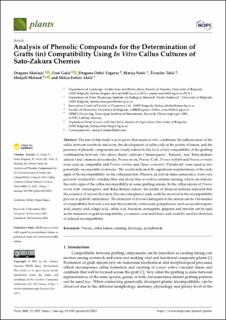Analysis of phenolic compounds for the determination of grafts (In) compatibility using in vitro callus cultures of Sato-zakura cherries
| dc.contributor.author | Skočajić, Dragana | |
| dc.contributor.author | Gašić, Uroš | |
| dc.contributor.author | Zagorac, Dragana Dabic´ | |
| dc.contributor.author | Nešić, Marija | |
| dc.contributor.author | Tešić, Živoslav | |
| dc.contributor.author | Meland, Mekjell | |
| dc.contributor.author | Akšić, Milica Fotirić | |
| dc.date.accessioned | 2022-03-02T14:16:27Z | |
| dc.date.available | 2022-03-02T14:16:27Z | |
| dc.date.created | 2022-02-21T11:48:38Z | |
| dc.date.issued | 2021-12-20 | |
| dc.identifier.citation | Plants. 2021, 10 (12), . | en_US |
| dc.identifier.issn | 2223-7747 | |
| dc.identifier.uri | https://hdl.handle.net/11250/2982586 | |
| dc.description.abstract | The aim of this study was to prove that under in vitro conditions, the adhesiveness of the callus between rootstock and scion, the development of callus cells at the points of fusion, and the presence of phenolic components are closely related to the level of (in) compatibility of the grafting combinations between Sato-zakura cherry cultivars (‘Amanogawa’, ‘Kanzan’, and ‘Kiku-shidare-zakura’) and commercial rootstocks. Prunus avium, Prunus ‘Colt’, Prunus mahaleb and Prunus serrulata were used as compatible and Prunus serotina and Pyrus communis ‘Pyrodwarf’ were used as two potentially incompatible rootstocks. The results indicated the significant manifestations of the early signs of the incompatibility on the callus junction. Phenols, as well as tissue senescence, were very precisely localized by toluidine blue and alcian blue as well as safranin staining, which can indicate the early signs of the callus incompatibility in some grafting unions. In the callus unions of Prunus avium with ‘Amanogawa’ and ‘Kiku-shidare-zakura’ the results of chemical analyses indicated that the existence of several flavonols, flavones and phenol acids could be involved in the incompatibility process in grafted combination. The detection of flavonol astragalin in the unions can be a biomarker of compatibility between scion and the rootstock, while some polyphenols, such as neochlorogenic acid, sinapic acid, ellagic acid, caffeic acid, baicalein, naringenin, apigenin and luteolin can be used as the indicators of graft incompatibility. p-coumaric acid and ferulic acid could be used for detection of delayed incompatibility. | en_US |
| dc.language.iso | eng | en_US |
| dc.publisher | MDPI, Basel, Switzerland | en_US |
| dc.rights | Navngivelse 4.0 Internasjonal | * |
| dc.rights.uri | http://creativecommons.org/licenses/by/4.0/deed.no | * |
| dc.title | Analysis of phenolic compounds for the determination of grafts (In) compatibility using in vitro callus cultures of Sato-zakura cherries | en_US |
| dc.type | Peer reviewed | en_US |
| dc.type | Journal article | en_US |
| dc.description.version | publishedVersion | en_US |
| dc.rights.holder | © 2021 by the authors | en_US |
| dc.source.pagenumber | 19 | en_US |
| dc.source.volume | 10 | en_US |
| dc.source.journal | Plants | en_US |
| dc.source.issue | 12 | en_US |
| dc.identifier.doi | 10.3390/plants10122822 | |
| dc.identifier.cristin | 2004007 | |
| dc.relation.project | Norges forskningsråd: 309416 | en_US |
| dc.source.articlenumber | 2822 | en_US |
| cristin.ispublished | true | |
| cristin.fulltext | original | |
| cristin.qualitycode | 1 |
Tilhørende fil(er)
Denne innførselen finnes i følgende samling(er)
-
Divisjon for matproduksjon og samfunn [1012]
Publikasjoner knyttet til ansatte ved Divisjon for matproduksjon og samfunn -
Publikasjoner fra CRIStin - NIBIO [4531]
-
Vitenskapelige artikler [1416]

